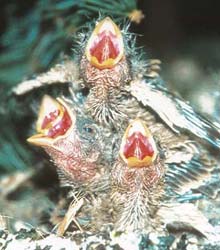Mother Finch Controls Baby’s Sex to Increase Survival Odds

Image ©Science/A. Badyaev
Most mothers-to-be must simply hope for healthy offspring. But female house finches tip the odds in their babies’ favor by pre-determining their gender, a new study suggests. According to a report published in the current issue of the journal Science, enterprising mother house finches adjust the sex and growth of their offspring to account for the order in which the eggs are laid, thereby reducing the mortality of their sons and daughters by 10 to 20 percent.
Alexander Badyaev of the University of Montana, Missoula, and colleagues studied two populations of the house finch, Carpodacus mexicanus, that have diverged significantly over the past 20 years. The scientists found predictable patterns in how a baby finch’s sex and position in the laying order affected both its growth pattern and its chance of survival. In the Montana population, first-born females exhibited better survival odds than their male counterparts did. But in Alabama, first-born males survived more often. Such survival discrepancies seem to drive maternal finches to select whether sons or daughters hatch first. “Breeding females in both Montana and Alabama populations lay male and female eggs in different sequences within clutches,” the authors write, “thus placing sons and daughters in the most advantageous positions for survival in that particular environment.”
Exactly how finch mothers control their offspring’s sex, survival and growth remains a mystery. The researchers note that such adjustments facilitate adaptation to local environments. Observing such acclimatization, they conclude, provides “empirical support for the hypothesis that parental effects play a crucial role at the initial stages of population divergence by enabling establishment of populations in novel environments.”
Media Contact
All latest news from the category: Life Sciences and Chemistry
Articles and reports from the Life Sciences and chemistry area deal with applied and basic research into modern biology, chemistry and human medicine.
Valuable information can be found on a range of life sciences fields including bacteriology, biochemistry, bionics, bioinformatics, biophysics, biotechnology, genetics, geobotany, human biology, marine biology, microbiology, molecular biology, cellular biology, zoology, bioinorganic chemistry, microchemistry and environmental chemistry.
Newest articles

A universal framework for spatial biology
SpatialData is a freely accessible tool to unify and integrate data from different omics technologies accounting for spatial information, which can provide holistic insights into health and disease. Biological processes…

How complex biological processes arise
A $20 million grant from the U.S. National Science Foundation (NSF) will support the establishment and operation of the National Synthesis Center for Emergence in the Molecular and Cellular Sciences (NCEMS) at…

Airborne single-photon lidar system achieves high-resolution 3D imaging
Compact, low-power system opens doors for photon-efficient drone and satellite-based environmental monitoring and mapping. Researchers have developed a compact and lightweight single-photon airborne lidar system that can acquire high-resolution 3D…





















